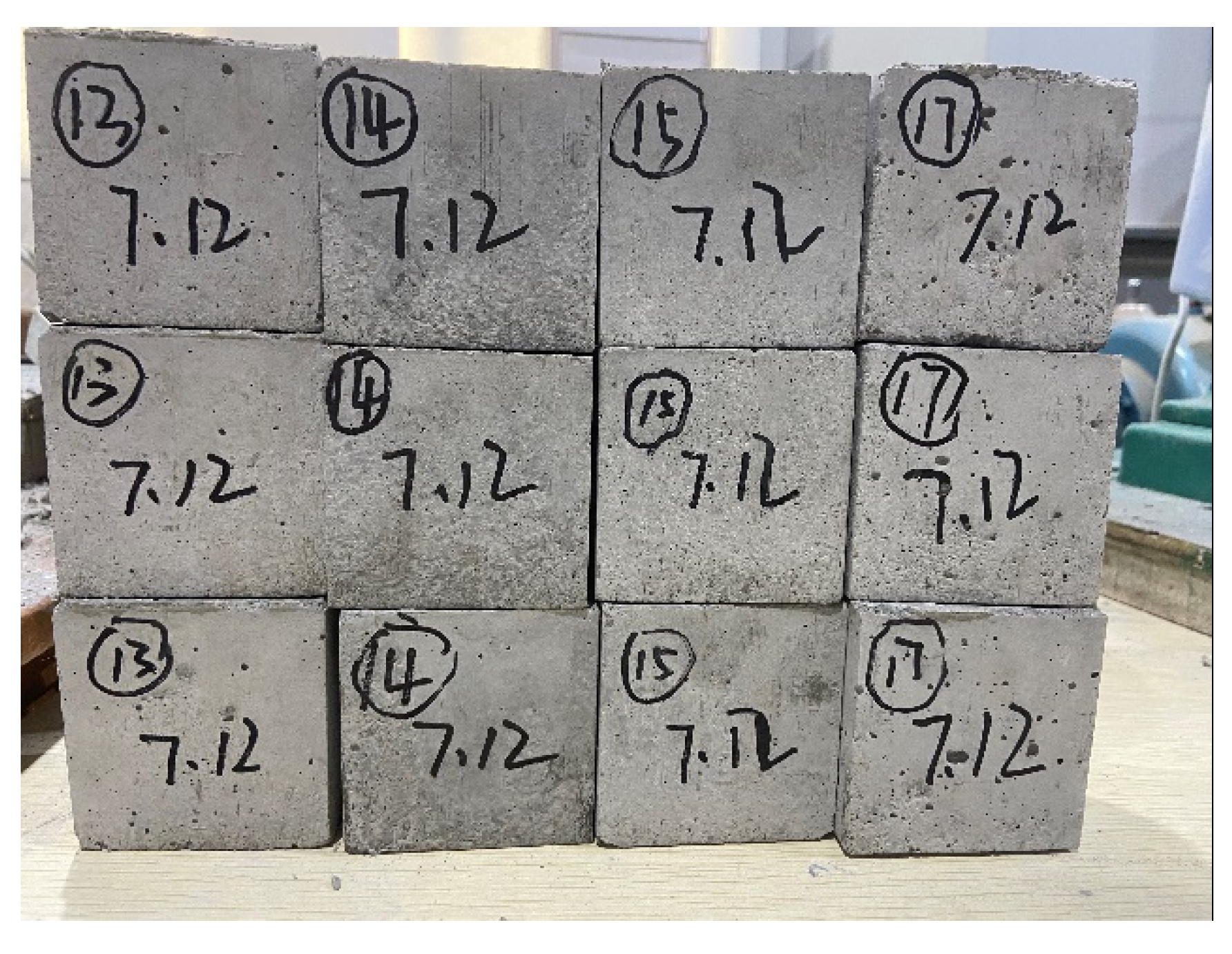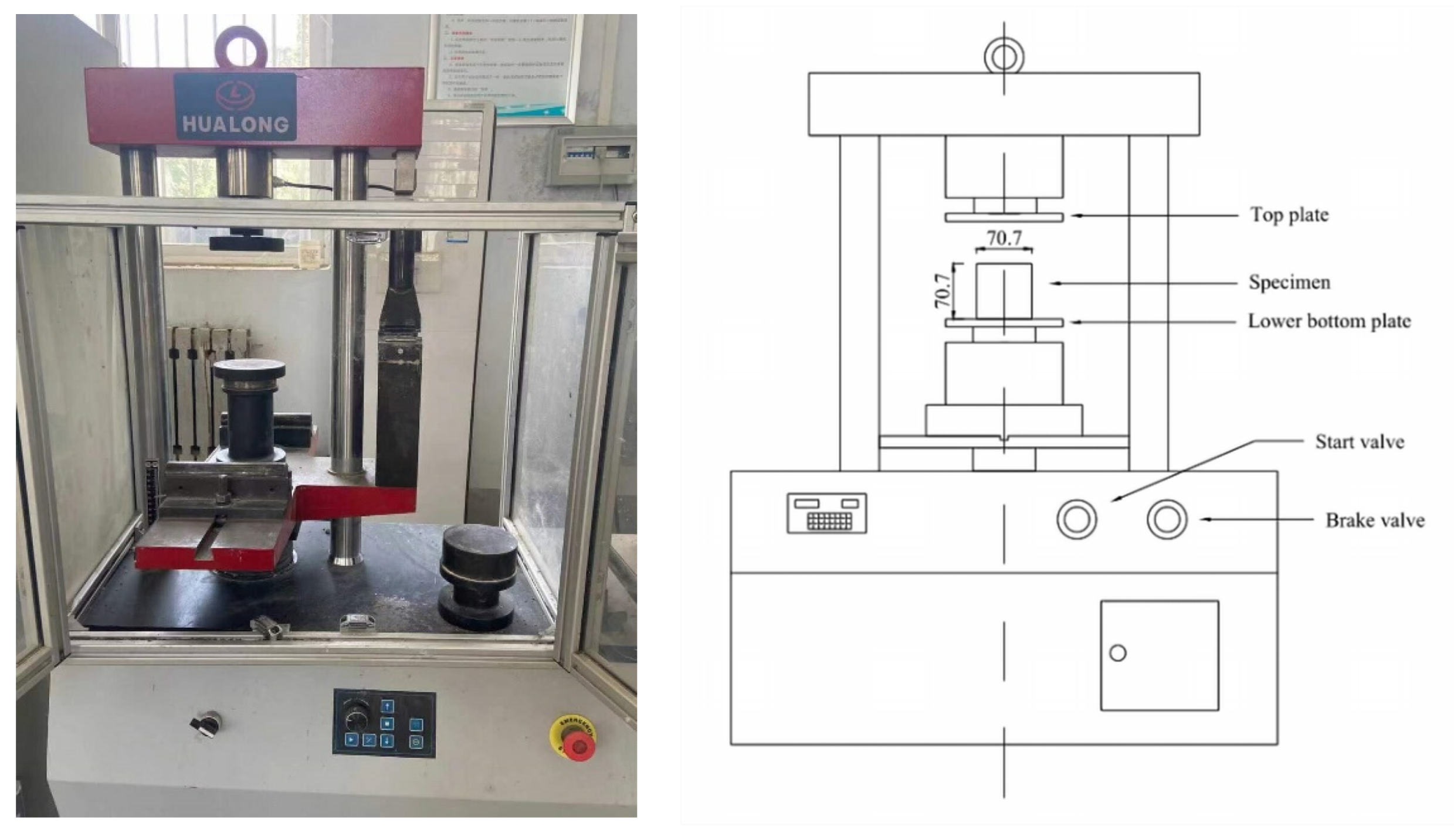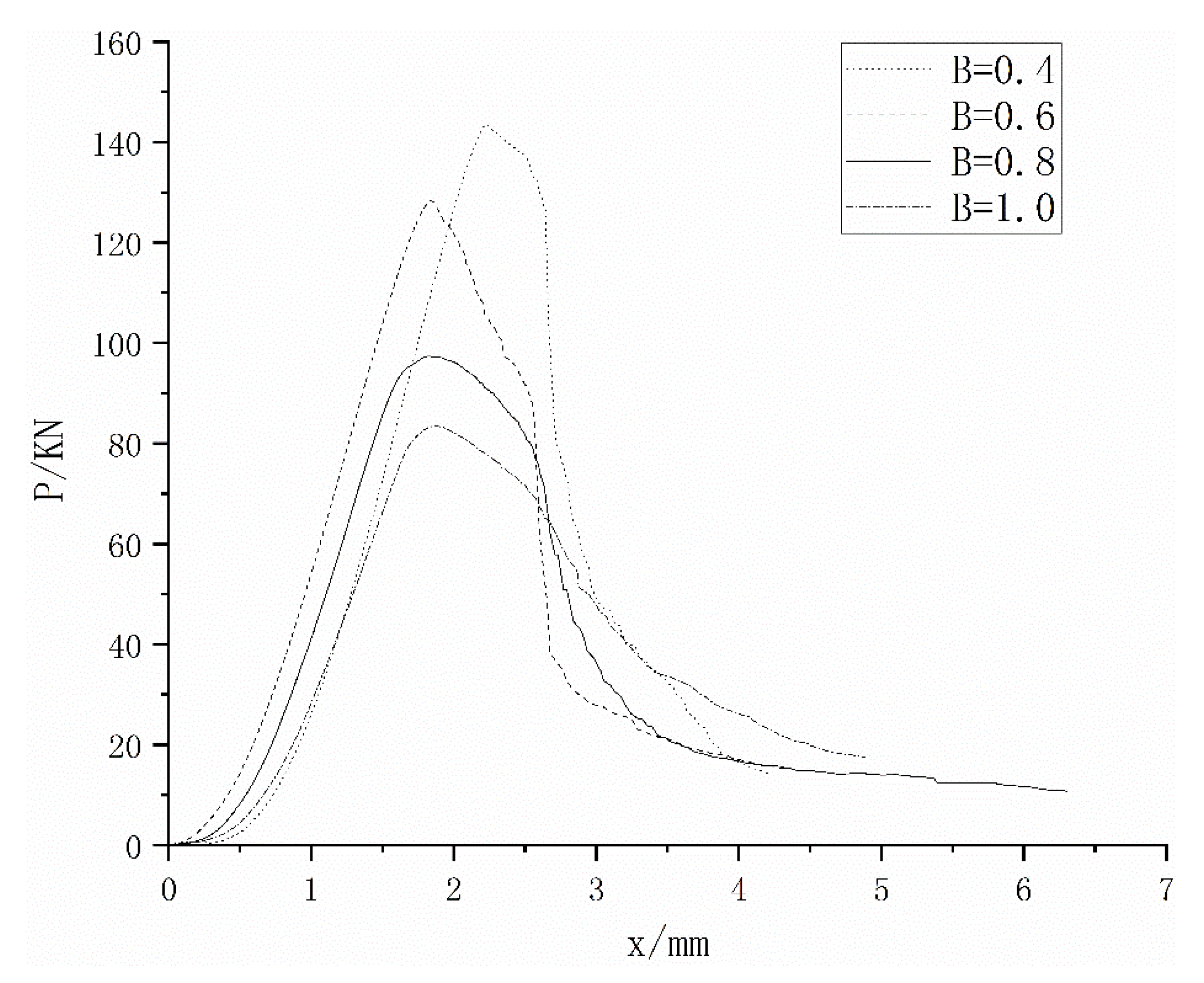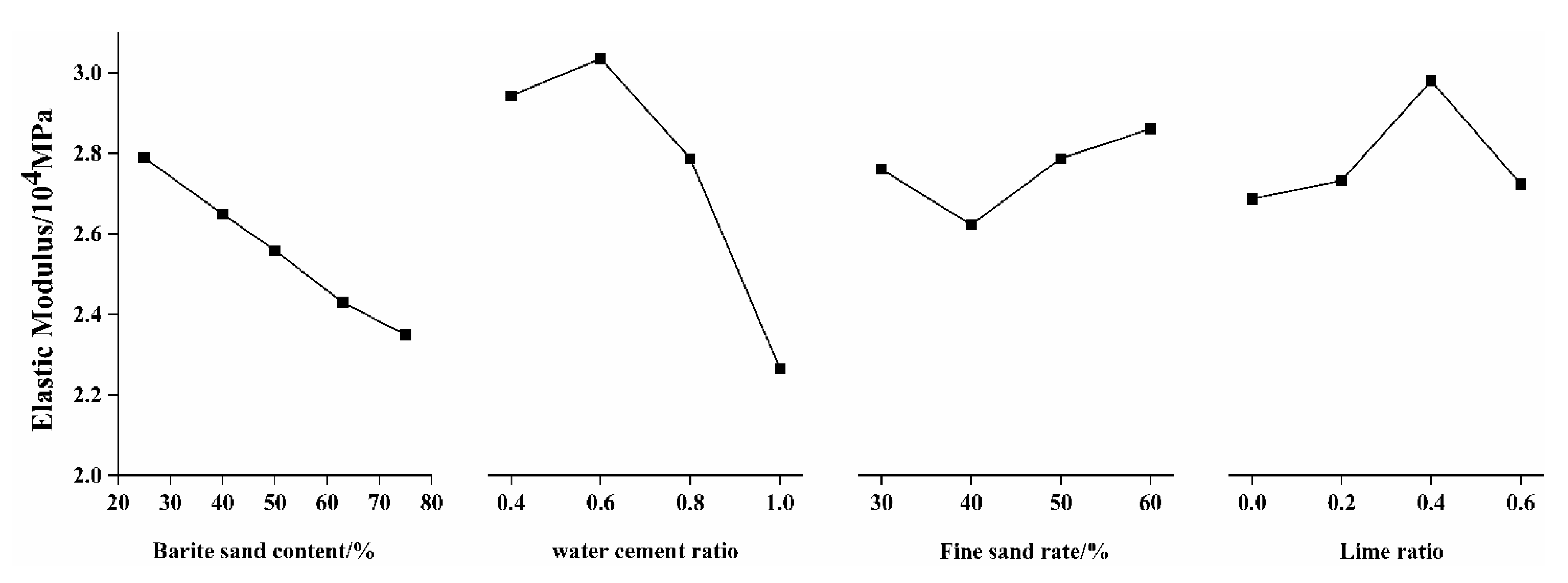Study on the Material Properties of Microconcrete by Dynamic Model Test
Abstract
:1. Introduction
2. Model Material Similarity Theory
3. Performance Test of Microconcrete
3.1. Raw Material Selection
3.2. Experimental Design
3.3. Test Method
- load when stress is 1/3 axial compressive strength (N);
- initial load when stress is 0.5 Mpa (N);
- A pressure bearing area (mm2);
- L measuring gauge length (mm);
- the average value of the deformation on both sides of the specimen during the last loading from to ;
- the average value of the deformation on both sides of the specimen when the load is ;
- the average value of the deformation on both sides of the specimen when the load is .
4. Analysis of Test Results
4.1. Full Curve of Compressive Load and Displacement
4.2. Analysis of Orthogonal Test Results
- (1)
- Density
- (2)
- Compressive strength
- (3)
- Elastic modulus
4.3. Destruction Morphology Analysis
5. Conclusions
- (1)
- It can be known from the experimental data that this orthogonal experimental level design can include the main influence interval, and the effect is relatively ideal. Using range analysis and variance analysis, it is concluded that the sensitivity of each factor to density is ranked as follows: barite sand content > water–cement ratio > fine sand ratio > lime ratio. The order of sensitivity of compressive strength and elastic modulus is: barite sand content > water–cement ratio > lime ratio > fine sand ratio. The stress–strain curve and failure form of microconcrete are the same as those of ordinary concrete, but the strain corresponding to the same peak stress is larger, and the width of the failure zone is smaller than that of ordinary concrete.
- (2)
- The performance indicators of microconcrete under different mix ratios have a wide range of changes, with a minimum of 19% and a maximum of 102%. The density range is 2.37–2.81 g/cm3, the cubic compressive strength range is 18.37–36.94 MPa, and the elastic modulus range is 2.11 × 104–3.28 × 104 MPa. Moreover, the distribution range can be wider as the control factor level changes. A wide range of index distribution can better meet the model similarity ratio design and provide a reference for the preparation of different structural model tests of microconcrete.
- (3)
- Barite sand has the most significant control effect on the density of microconcrete, and the water–cement ratio has the most significant effect on the compressive strength and elastic modulus of microconcrete. Therefore, to prepare microconcrete that meets the similar ratio conditions of the model shaking table test, it is first necessary to adjust the water–cement ratio to make the strength and elastic modulus of the microconcrete within the corresponding range, and then adjust the amount of barite sand to make the material density meet the density similarity condition of the fluid–solid coupling structure. Finally, the material properties are fine-tuned through the fine sand ratio, particle size gradation, and lime ratio to achieve the optimal mix ratio that meets the similarity ratio of the model.
Author Contributions
Funding
Institutional Review Board Statement
Informed Consent Statement
Data Availability Statement
Acknowledgments
Conflicts of Interest
References
- Liu, Y.; Hu, B.; Yan, J. Applicability of Housner Model in seismic Calculation of aqueduct. J. Hydraul. Eng. 2002, 9, 94–99. [Google Scholar]
- Li, Y.; Lai, M. A proposed formula for equivalent model of fluid sloshing in rectangular vessel. Earthq. Eng. Eng. Vib. 2013, 33, 124–127. [Google Scholar]
- Li, Y.; Di, Q.; Gong, Y. Equivalent mechanical models of sloshing fluid in arbi-trary-section aqueducts. Earthq. Eng. Struct. Dyn. 2012, 41, 1069–1087. [Google Scholar] [CrossRef]
- Chang, H.; Wu, Z.; Zhu, Y.; Ma, R. Investigation on Fluid-Structure Interaction of a Steel Truss Aqueduct under Seismic Force. J. Phys. Conf. Ser. 2021, 1985, 012057. [Google Scholar] [CrossRef]
- Wang, H.; Li, C.; Zhao, L. Experimental Study on Dynamic Interaction between Large U-Shape Aqueduct and Water. KSCE J. Civ. Eng. 2022, 26, 1203–1213. [Google Scholar] [CrossRef]
- Li, Y.; Yu, Y.; Wang, Z. Equivalent simplified model of seismic computational fluid for round pipe aqueduct. South North Water Transf. Water Sci. Technol. 2015, 13, 1101–1104. [Google Scholar]
- Li, Y.; Lou, M. Boundary Element Simulation of nonlinear sloshing in aqueduct. Seism. Eng. Eng. Vib. 2000, 51–56. [Google Scholar]
- Liu, Y.; Yu, M.; Chen, H. Finite Element Method for Hydrodynamic Coupling Analysis of Fluid and solid. Eng. Mech. 2005, 1–6. [Google Scholar]
- Liu, Y.; Dang, K.; Dong, J. Finite element analysis of the aseismicity of a large aqueduct. Soil Dyn. Earthq. Eng. 2017, 94, 102–108. [Google Scholar] [CrossRef]
- Wu, Y.; Mo, H.H.; Yang, C. Study on dynamic performance of a three-dimensional high frame supported U-shaped aqueduct. Eng. Struct. 2006, 28, 372–380. [Google Scholar] [CrossRef]
- Li, Z.; Zhou, Z.; Zhu, X. Influence of pier height on horizontal seismic response of aqueduct structure. Earthq. Eng. Eng. Vib. 2013, 33, 245–257. [Google Scholar]
- Ying, L.; Meng, X.; Zhou, D.; Xu, X.; Zhang, J.; Li, X. Sloshing of fluid in a baffled rectangular aqueduct considering soil-structure interaction. Soil Dyn. Earthq. Eng. 2019, 122, 132–147. [Google Scholar] [CrossRef]
- Jiang, Y.; Song, Y. Experimental study on seismic performance of super large aqueduct. China Rural. Water Hydropower 2010, 12, 100–103 + 106. [Google Scholar]
- Li, Y.; Wang, Y.; Fu, X.; Du, B. Shaking table test of pile-soil interaction in large-scale aqueduct. Civ. Archit. Environ. Eng. 2010, 32, 57–62 + 68. [Google Scholar]
- Xia, F.; Song, Y.; Li, J.; Yao, X. Experimental study on dynamic characteristics of large-scale aqueduct isolation system. South North Water Transf. Water Sci. Technol. 2009, 7, 59–61 + 72. [Google Scholar]
- Duan, Q.H.; Lou, M.L. Shaking Table Model Test for Vertical Seismic Response of Bent-Type Aqueduct. Adv. Mater. Res. 2011, 163–167, 4156–4164. [Google Scholar] [CrossRef]
- Jiang, Y.J.; Zhou, Y.G.; Song, Y.L. Experimental Study on Seismic Isolation Bearing of Large Aqueduct. Appl. Mech. Mater. 2012, 226–228, 1693–1696. [Google Scholar] [CrossRef]
- Wang, H.; Li, C.; Zhang, K. Experimental Study on sloshing Convection in U-shaped aqueduct. J. Hydraul. Eng. 2020, 51, 1453–1461. (In Chinese) [Google Scholar]
- Wang, H.; Li, C.; Zhu, C.; He, J. Study on fluid-structure Interaction of large-scale thin-walled aqueduct by Shaking table Test. J. Hydraul. Eng. 2020, 51, 653–663. [Google Scholar]
- Liu, H.; Li, H. Study on elastic modulus of Materials in Similar Design of Seismic Simulation Shaking table Test Model. Vib. Shock. 2016, 35, 114–120. [Google Scholar]
- Khan, H. Concrete rectification using micro-concrete form-and-pour technique. Constr. Eng. Aust. 2019, 5, 52–56. [Google Scholar]
- Li, L.; Guo, W. Experimental study on basic mechanical properties and influence parameters of microconcrete. World Earthq. Eng. 2016, 32, 277–283. [Google Scholar]
- Quan, D.; Wang, Y.; Ma, P.; Jing, Y.; Chen, S. Shaking table test of medium and small scale than the model experimental study materials. Ind. Constr. 2016, 46–48, 98–103. [Google Scholar]
- Huo, J.; Zheng, Q.; Chen, B.; Xiao, Y. Tests on impact behaviour of micro-concrete-filled steel tubes at elevated temperatures up to 400 °C. Mater. Struct. 2009, 42, 1325–1334. [Google Scholar] [CrossRef]
- Shen, D.; Lü, X. Experimental study on the mechanical property of microconcrete in model test. Tumu Gongcheng Xuebao/China Civil. Eng. J. 2010, 43, 14–21. [Google Scholar]
- Yang, Z.; Liao, H.; Lou, K. Experimental study of the full curve of the stress-strain relationship for microconcrete. Eng. Mech. 2002, 19, 90–94. [Google Scholar] [CrossRef]
- Dejian, S.; Lu, X. Experimental study on dynamic compressive properties of microconcrete under different strain rate. In Proceedings of the 14th World Conference on Earthquake Engineering, Beijing, China, 12–17 October 2008. [Google Scholar]
- Shi, G.; Li, H.; Liu, X.; Liu, Z.; Wang, B. Transport Performance Improvement of a Multiphase Pump for Gas–Liquid Mixture Based on the Orthogonal Test Method. Processes 2021, 9, 1402. [Google Scholar] [CrossRef]
- Zhou, J.; Zhao, M.; Wang, C.; Gao, Z. Optimal Design of Diversion Piers of Lateral Intake Pumping Station Based on Orthogonal Test. Shock. Vib. 2021, 2021, 6616456. [Google Scholar] [CrossRef]











| Aggregate | Mesh Size/mm | |||||
|---|---|---|---|---|---|---|
| 5.000 | 2.500 | 1.250 | 0.625 | 0.313 | 0.156 | |
| Barite sand | 13.64% | 52.18% | 60.26% | 74.69% | 86.33% | 96.43% |
| quartz sand | 6.52% | 43.72% | 54.38% | 69.27% | 80.59% | 95.87% |
| Index | Standard Value | Test Value |
|---|---|---|
| Specific surface area/m2·kg−1 | ≥300 | 374 |
| Initial setting time/min | ≥45 | 171 |
| Final setting time/min | ≤600 | 217 |
| Stability/mm | ≤4 | 1.5 |
| 28-day compressive strength/MPa | ≥42.5 | 45 |
| 28-day flexural strength/MPa | ≥6.5 | 8.5 |
| Standard consistency water consumption/% | 27–31 | 27.4 |
| Test Number | Influencing Factors | Mix Ratio | Density | Compressive Strength | Elastic Modulus | |||
|---|---|---|---|---|---|---|---|---|
| A | B | C | D | |||||
| T-1 | 1 | 1 | 4 | 1 | 1:1:3:0:0.4 | 2.47 | 40.73 | 3.28 |
| T-2 | 1 | 2 | 1 | 3 | 1:1.25:3.75:0.2:0.6 | 2.45 | 36.13 | 3.16 |
| T-3 | 1 | 3 | 2 | 2 | 1:1.5:4.5:0.4:0.8 | 2.42 | 33.14 | 3.08 |
| T-4 | 1 | 4 | 3 | 4 | 1:2:6:0.6:1.0 | 2.37 | 18.37 | 2.45 |
| T-5 | 2 | 1 | 4 | 2 | 1:2:3:0:0.4 | 2.62 | 36.94 | 3.18 |
| T-6 | 2 | 2 | 3 | 3 | 1:2:3:0.2:0.6 | 2.59 | 34.55 | 3.12 |
| T-7 | 2 | 3 | 2 | 4 | 1:2.5:3.75:0.4:0.8 | 2.58 | 30.13 | 2.98 |
| T-8 | 2 | 4 | 1 | 1 | 1:3:4.5:0.6:1.0 | 2.55 | 22.09 | 2.35 |
| T-9 | 3 | 1 | 2 | 4 | 1:2:2:0:0.4 | 2.69 | 35.54 | 3.06 |
| T-10 | 3 | 2 | 1 | 1 | 1:2.5:2.5:0.2:0.6 | 2.67 | 36.62 | 3.15 |
| T-11 | 3 | 3 | 3 | 3 | 1:2.5:2.5:0.4:0.8 | 2.59 | 38.26 | 2.86 |
| T-12 | 3 | 4 | 4 | 2 | 1:3:3:0.6:1.0 | 2.58 | 19.92 | 2.34 |
| T-13 | 4 | 1 | 4 | 1 | 1:2.5:1.5:0:0.4 | 2.69 | 33.80 | 2.86 |
| T-14 | 4 | 2 | 3 | 3 | 1:2.5:1.5:0.2:0.6 | 2.67 | 36.57 | 3.18 |
| T-15 | 4 | 3 | 1 | 2 | 1:2.5:1.5:0.4:0.8 | 2.63 | 23.15 | 2.70 |
| T-16 | 4 | 4 | 2 | 4 | 1:3:1.8:0.6:1.0 | 2.58 | 18.48 | 2.18 |
| T-17 | 5 | 1 | 1 | 4 | 1:3:1:0:0.4 | 2.81 | 25.90 | 2.78 |
| T-18 | 5 | 2 | 4 | 3 | 1:3:1:0.2:0.6 | 2.77 | 29.25 | 3.02 |
| T-19 | 5 | 3 | 3 | 2 | 1:3.75:1.25:0.4:0.8 | 2.76 | 27.29 | 2.68 |
| T-20 | 5 | 4 | 2 | 1 | 1:3.75:1.25:0.6:1.0 | 2.63 | 19.43 | 2.11 |
| Level | Density | Compressive Strength | Elastic Modulus | |||||||||
|---|---|---|---|---|---|---|---|---|---|---|---|---|
| A | B | C | D | A | B | C | D | A | B | C | D | |
| 1 | 2.43 | 2.66 | 2.62 | 2.60 | 34.09 | 34.58 | 26.78 | 30.53 | 2.79 | 3.03 | 2.83 | 2.75 |
| 2 | 2.59 | 2.64 | 2.58 | 2.59 | 30.93 | 34.62 | 27.34 | 28.09 | 2.65 | 3.13 | 2.68 | 2.80 |
| 3 | 2.63 | 2.60 | 2.60 | 2.62 | 32.59 | 28.40 | 29.01 | 26.95 | 2.56 | 2.86 | 2.86 | 3.07 |
| 4 | 2.64 | 2.54 | 2.63 | 2.61 | 28.00 | 19.66 | 26.13 | 24.68 | 2.43 | 2.29 | 2.94 | 2.79 |
| 5 | 2.74 | - | - | - | 25.47 | - | - | - | 2.35 | - | - | - |
| Range value | 0.31 | 0.12 | 0.05 | 0.03 | 8.62 | 14.96 | 4.88 | 6.27 | 0.44 | 0.84 | 0.26 | 0.28 |
| Consideration Index | Single Factor Significance | Influencing Factors | |||
|---|---|---|---|---|---|
| A | B | C | D | ||
| Density | F | 17.76 | 4.5 | 0.13 | 0.056 |
| α = 0.1 | Significant | Significant | Non-significant | Non-significant | |
| α = 0.05 | Significant | Significant | Non-significant | Non-significant | |
| Compressive strength | F | 8.70 | 2.53 | 0.79 | 0.95 |
| α = 0.1 | Significant | Significant | Non-significant | Non-significant | |
| α = 0.05 | Significant | Non-significant | Non-significant | Non-significant | |
| Elastic Modulus | F | 9.32 | 1.64 | 0.88 | 1.04 |
| α = 0.1 | Significant | Non-significant | Non-significant | Non-significant | |
| α = 0.05 | Significant | Non-significant | Non-significant | Non-significant | |
Publisher’s Note: MDPI stays neutral with regard to jurisdictional claims in published maps and institutional affiliations. |
© 2022 by the authors. Licensee MDPI, Basel, Switzerland. This article is an open access article distributed under the terms and conditions of the Creative Commons Attribution (CC BY) license (https://creativecommons.org/licenses/by/4.0/).
Share and Cite
Zhang, C.; Zhang, J.; Ren, Q.; Xu, J.; Wang, B. Study on the Material Properties of Microconcrete by Dynamic Model Test. Materials 2022, 15, 3432. https://doi.org/10.3390/ma15103432
Zhang C, Zhang J, Ren Q, Xu J, Wang B. Study on the Material Properties of Microconcrete by Dynamic Model Test. Materials. 2022; 15(10):3432. https://doi.org/10.3390/ma15103432
Chicago/Turabian StyleZhang, Chunyu, Jinpeng Zhang, Qichao Ren, Jianguo Xu, and Bo Wang. 2022. "Study on the Material Properties of Microconcrete by Dynamic Model Test" Materials 15, no. 10: 3432. https://doi.org/10.3390/ma15103432
APA StyleZhang, C., Zhang, J., Ren, Q., Xu, J., & Wang, B. (2022). Study on the Material Properties of Microconcrete by Dynamic Model Test. Materials, 15(10), 3432. https://doi.org/10.3390/ma15103432






